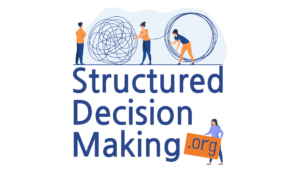Decision Sketching
Decision sketching involves walking through the first few steps of a decision problem quickly, in order to clarify key aspects of the decision, determine the best way to frame it, and inform the design of the decision process.
Depending on the complexity of your decision, you might take a few minutes, hours or a day, and work through the first few steps. Clarify the decision context – what are we really trying to decide about, and does everyone have the same idea about it? Starting with a plausible frame, identify the key objectives – what are we trying to achieve or avoid and what specific measures or metrics could we use to compare alternatives? Generate alternatives – what’s the range of possible things we could be looking at, and do we have a common understanding of what’s in and out of scope? Identify what information we’ll need, and the amount of effort we’ll have to put into getting it. Look ahead – what do we think will be the key hurdles to reaching agreement? Will there be hard value trade-offs? What information will we need to be able to make them? Are there likely to be critical uncertainties? How might we prepare ourselves to deal with them? Who needs to be involved for us to be successful? What are the likely barriers that could trip us up and what do we need to do to overcome them? Put on some other hats: what might our key partners and stakeholders think about the scope and frame of the decision?
Sketching can be done as an internal exercise with the planning team, or stakeholders and/or partners can be invited to participate. When sketching, it is important to avoid getting bogged down by any particular issue and resist the urge to solve the problem right away. The purpose is to map out a possible future of where the analysis is likely to lead and obtain insights.
The sketch often reveals that there is a better way to frame the decision. With a few hours or days spent on sketching, you can avoid months of effort working on the wrong decision.
From the sketch, you will also have a good idea of where to focus your attention. In any multi-criteria decision problem, most of the steps of SDM will be relevant. However, the relative amount of effort you put into them can vary tremendously. For example, the meat of some problems is right at the framing stage. Once that is nailed, the rest of the decision could be quite simple. Sometimes the objectives are clear and what needs a lot of work is structuring alternatives, whereas in other situations, the alternatives are clear but objectives need clarification. Sometimes there are critical uncertainties that warrant in-depth treatment with decision trees, probabilistic modeling and-or sensitivity analysis, or that drive a shift to an Adaptive Management approach early on. Sometimes the key challenge is working with diverse stakeholders on difficult value-trade-offs. Regardless of where the analytical attention is, its usually valuable to understand how that analysis fits into the broader decision process.
When you approach your problem as a decision from the beginning, it changes your point of entry, and forces you to think about things in a different way. It typically surfaces key issues much earlier in the process and helps to avoid falling into technical rabbit holes. It changes much of what follows – how you allocate resources, who you engage and how, what kind of analysis you do, and who you have on your team.
After the sketch, you may or may not conclude that you want to launch a full SDM process; perhaps the sketch revealed the answer! But you will almost certainly find you have a better understanding of your problem, a more common understanding among the people involved, and clarity about the path forward.

